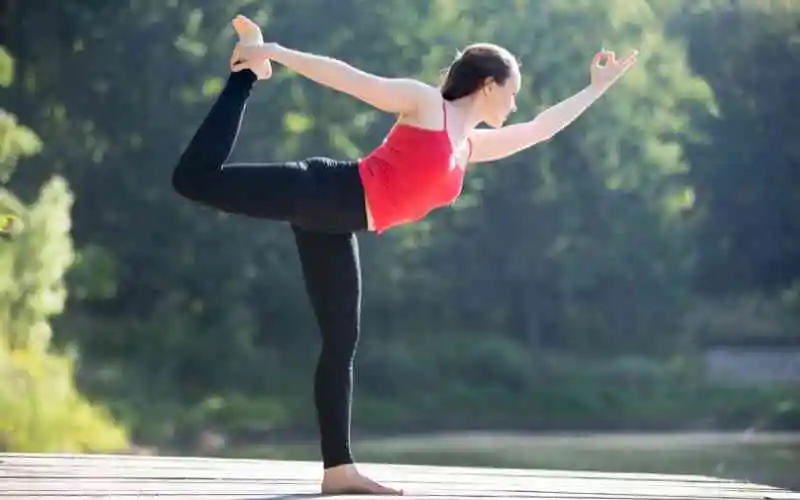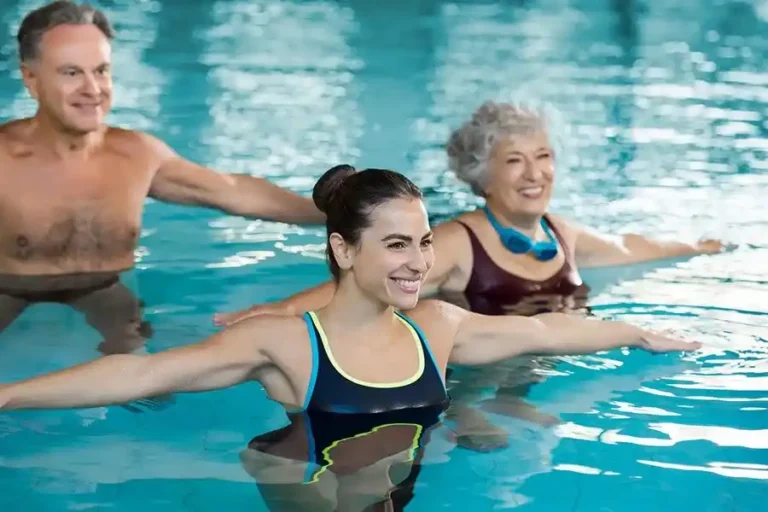Natarajasana (Dancer Pose)
Natarajasana, commonly known as the Dancer Pose, is a graceful and iconic yoga posture that embodies balance, strength, and flexibility. Its name is derived from the Sanskrit words “Nata” (dancer), “Raja” (king), and “Asana” (pose), symbolizing the cosmic dance of Lord Shiva, often depicted in Hindu mythology as Nataraja, the Lord of Dance.
What is Natarajasana?
Natarajasana is a well-liked yoga pose that improves flexibility, strength, and balance. It bears the name of Lord Shiva, who is frequently portrayed in Hindu mythology as the heavenly dancer.
Its name comes from the Sanskrit name for this yoga pose, Natarajasana, which is derived from the words “Asana,” which means posture, “Raja,” which means kindness, and “Nata,” which means dancer or actress. It is occasionally referred to by a different name than “Dancer’s Pose” or “Lord of the Dance Pose.”
This yoga pose has two variations that are used every day. One hand must be used to hold the boosted leg, and both hands must be held overhead for the boosted foot in the second, evolved position.
Which muscles are used in Natarajasana?
- Hamstrings
- Quadriceps
- Calves
- Glutes
- Adductors
- Abdominals
- Back muscles
- Latissimus dorsi
- Deltoids
- Rotator cuff muscles
- Biceps
- Pectoralis major and minor
- Neck extensors
What are the benefits of Natarajasana?
1. Improves balance and concentration
Focused attention is necessary for natarajasana, which helps to enhance neuro-muscular coordination by involving the brain in balance control and concentration.
2. Strengthens leg muscles
The muscles in the thighs, calves, and ankles are activated and strengthened when the standing leg supports the body’s weight.
3. Enhances flexibility of the spine
Natarajasana encourages spinal flexibility, stretching, and toning of the muscles along the vertebral column when you arch your back.
4. Opens the chest and shoulders
The backward extension of the raised leg expands the shoulders and chest, enhancing posture and respiratory function.
5. Stimulates the abdominal organs
The balancing element aids digestion, activates the core, and stimulates the abdominal organs.
6. Improves hip flexor flexibility
The position of the raised leg helps to develop flexibility and decrease stiffness by strengthening and stretching the hip flexors.
7. Promotes emotional well-being
Natarajasana’s expressive, elegant style helps reduce emotional stress and bring forth delight, which benefits mental health in general.
8. Benefits of Natarajasana for Weight Loss
By forcing you to balance on one leg, the Natraj pose works for several muscle groups in your body, strengthening your legs and core and encouraging muscular conditioning. This pose’s dynamic involvement helps you manage your weight by increasing your calorie expenditure. Regular Natarajasana practice may improve metabolism. you can add this pose in your workout if you are looking for weight loss.
9. Improves Blood Circulation
Your body’s blood circulation increases while you stretch and balance in the Nataraja dance poses. By guaranteeing the effective supply of nutrients and oxygen to different tissues, improved circulation supports the health of every organ.
10. Other Benefits of Natarajasana
In addition to enhancing coordination and balance, natarajasana has the following additional advantages:
- Promotes Mental Clarity: Concentration and mental clarity are fostered by the focus needed to maintain equilibrium. This mental exercise helps improve memory and cognitive performance.
- Reduces Stress: The pose’s focused breathing and concentration techniques can reduce stress and encourage relaxation, which benefits emotional health in general.
- Improves Posture: To offset the consequences of slouching, natarajasana can help restore posture and alignment by lengthening the spine and strengthening the back muscles.
- Increases Energy Levels: After practicing this dynamic pose, you will feel revitalized and exhilarated since it promotes circulation and oxygen flow.
How to do Natarajasana?
- Start with mountain pose, also known as Tadasana.
- Choose a location at eye level to concentrate on while applying firm, even pressure through your feet.
- Let go of the breath. Bend your left knee till it reaches your buttocks, then hold the outside of your left foot with your left hand. To make the standing leg powerful, engage your right thigh and knee and firmly press your right hip in.
- Maintain an erect posture, keep your chest open, and extend your tailbone downward. Push the left foot back into the hand as you inhale, lifting the leg until the thigh bone is parallel to the floor and the lower leg is vertical with the floor and at a right angle to the thigh bone. You can raise your right arm in front of you, either slightly higher next to your ear or parallel to the floor.
- Take five to ten deep breaths.
- Release the leg to exit the pose.
- Continue on the opposite side.
Natarajasana (Dancer Pose) video:
What are the Beginners’ Tips for Natarajasana?
- You can attempt this stance next to a wall if you have poor balance.
- A belt might assist you in achieving the pose’s full expression. Encircle your left foot with the belt. Verify that the strap is coming over your shoulder from behind. Next, walk your hands down the belt with your elbows pointing to the sky and your hands behind your back, then slowly elevate the foot.
What are the Modifications and Variations for Natarajasana?
As you go, make changes to move forward. Bring this stance step by step, removing it along the way when necessary.
Need a Modification?
If necessary, position yourself close to a wall so you may reach out with your hand for balance.
You could use a strap to assist you if you have trouble reaching or raising your lower leg.
Up for a Challenge?
Once you’re comfortable with the above-depicted asana, begin the following variations:
Push your left foot into your left elbow’s crook. To attach with your left hand, raise your right arm up and then your back.
This is essentially a Mermaid Pose in vertical form.
With your left elbow pointing upward toward the sky, change your grip on your left foot. To maintain the big toe side of the equal foot, the right-hand rises and comes up behind the left hand, which is gripping the outside of the foot. This must lead to a more comprehensive backend.
After using your left hand to grasp your left foot from above, position your right arm similarly and grasp the exact boosted foot. Your arms and feet are in the same posture as a full pigeon. Curl a strap around the foot to support and bridge the loop if you are unable to get your foot with both hands aloft. Booting the foot into the tied hands and raising the chest can help you balance and deepen the back bend.
Contraindications
- If you have surgery or injuries in your shoulders, hips, groins, or legs, stay away from this pose.
- This pose must be avoided by the individual with arthritis.
- This pose is not recommended for anyone with bulging discs, slipped discs, or severe back pain.
- Refrain from doing it if you have sacroiliac pain.
- It lowers blood pressure.
- People who have medial nerve compression, or carpal tunnel syndrome, should avoid this pose.
Conclusion
A difficult but rewarding yoga pose, natarajasana has several advantages, such as increased strength, flexibility, balance, and focus. The advantages of natarajasana can have a major impact on general health and wellness. But it’s crucial to be aware of any hazards and refrain from exerting too much effort.
By progressively building up your capacity to maintain this pose and with good coaching and focused execution, natarajasana can become a great addition to your yoga regimen. Use wisdom and respect for your body’s abilities when practicing this and other natraja dance sequence poses.
FAQs
What are the benefits of Natarajasana?
lessens anxiety, tension, and stress. enhances mental alertness and focus. increases the strength and suppleness of your arms, back, legs, and core. improves the pancreas, kidneys, and reproductive systems’ hormonal processes.
What does Natarajasana symbolize?
Shiva, the god of destruction, is portrayed as King Nataraja, who is embodied in Natarajasana, also known as King Dancer Pose. Shiva is a symbol of transformation. Death must accompany birth, and reconstruction must accompany devastation. Shiva is symbolized by Nataraja as the constant transformation of the cosmos.
What are the limitations of Natarajasana?
Physical Strength and Weak Body: Because this posture puts a lot of strain on the back, students with slip discs, excruciating back pain, or bulging discs should not perform it. Students who have low blood pressure, sacroiliac discomfort, arthritis, or cervical spondylosis should also avoid this pose.
What is the caution of Natarajasana?
Before performing Natarajasana, there are a few contraindications to take into account, just like with any other yoga pose. This position should be avoided or done with extreme caution by those who have neck ailments or lower back pain. This stance should also be avoided by those who have cardiac issues or excessive blood pressure.
References:
EkhartYoga. (2021b, March 4). Dancer’s Pose – Ekhart Yoga. Ekhart Yoga. https://www.ekhartyoga.com/resources/yoga-poses/dancers-pose
Bhattacharya, S. (2024, January 28). Dancer yoga pose: 7 benefits of Natarajasana and how to perform it. Healthshots. https://www.healthshots.com/fitness/staying-fit/benefits-of-dancer-yoga-pose-or-natarajasana/
Rosha, C. (2024, October 9). Benefits of Natarajasana (Dancer Pose) and How to Do it? Truemeds. https://www.truemeds.in/blog/benefits-of-natarajasana
JanviMangukiya, J. (2024g, October 24). Natarajasana (Dancer Pose) – Steps, Benefits, Variations – Mobile. Mobile Physiotherapy Clinic. https://mobilephysiotherapyclinic.in/natarajasana-dancer-pose/







